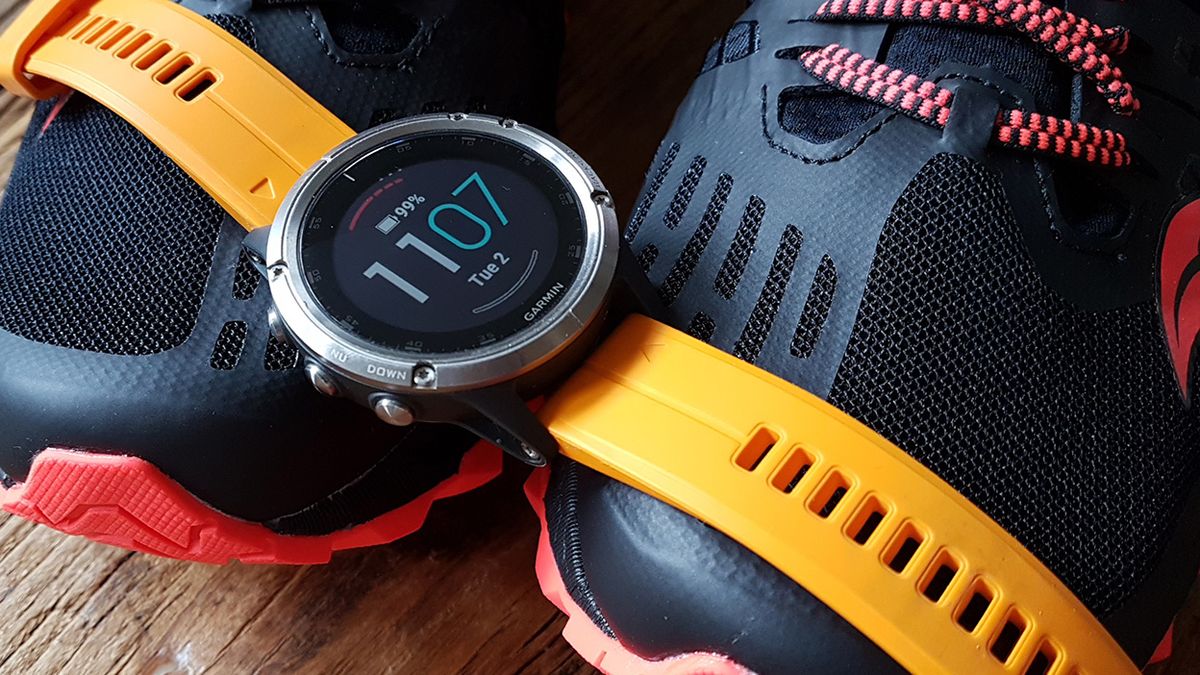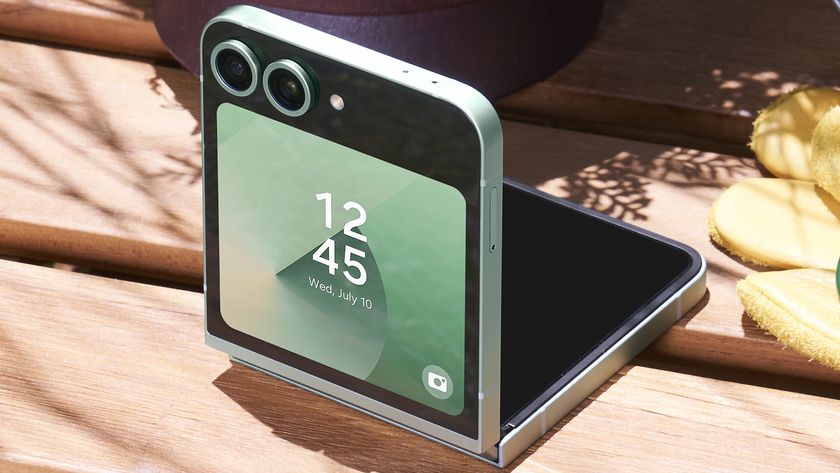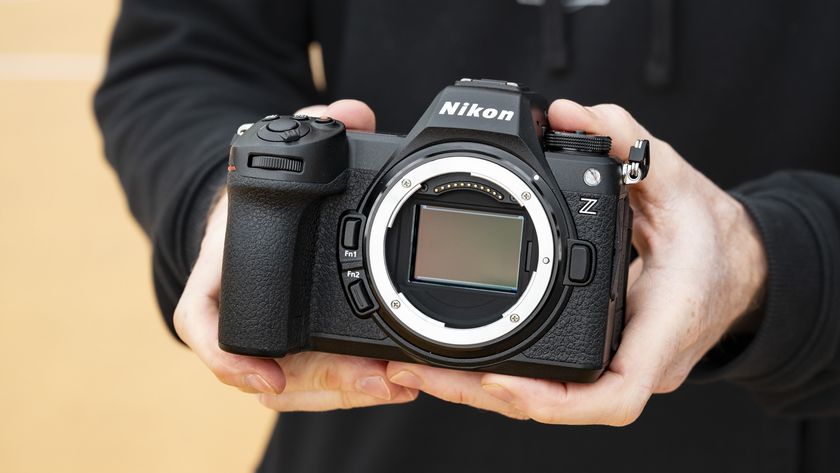TechRadar Verdict
When it comes to multisport watches, the refreshed Fenix is about as capable as they come, with new features like built-in music and contactless payments along with fully routable color topo maps. We’d like to have seen more battery and perhaps power and running dynamics baked in, but this is still the watch to beat. And boy does it need to be with that price tag.
Pros
- +
Hard wearing
- +
Stylish, rugged design
- +
Huge range of multi-sport features
Cons
- -
High price
- -
Reduced battery life
Why you can trust TechRadar
The Garmin Fenix 5 Plus is the predecessor of the Fenix 6, and although now a few years old, it's still one of the best multi-sport watches around
The fifth generation Fenix added three new watches to Garmin's line up, with the 5 Plus sitting alongside the Fenix 5S Plus and the Fenix 5X Plus. They’re still big, still bold but now they’re even more brilliantly well featured, bringing smartwatch skills to the mix.
They’re also still hugely expensive at full price, but you're likely to be able to grab a bargain on Prime Day 2021. Last year Amazon slashed 50% off the price of this superb Garmin watch, and although it's not the latest model, it's still a superb device (particularly at the right price).
There’s plenty to love about the Fenix 5 Plus. From trail running to open water swimming, the sport-specific tracking smarts are comprehensive, and there are advanced training and performance features to suit serious amateurs and professionals alike.
And when you throw in everyday activity tracking, smartwatch skills, Garmin Pay, music, solid sleep tracking and even stress monitoring, you get a watch that might – we say might very cautiously here – justify the price tag.
To find out, we put the middle sized, 47mm Garmin Fenix 5 Plus sapphire crystal titanium to the test.
Garmin Fenix 5 Plus release date and price
- Out now in the UK, US and AU
- Ranges from £599/$799.99/AU$1149 to £999/$1099.99/AU$1599
The Garmin Fenix 5 Plus is out now in the UK, US and Australia, but it's not cheap. Price-wise it ranges from £599 / $799.99 / AU$1149 to £999 / $1099.99 / AU$1599.
The differences in price are based on a combination of the size you pick, the materials used and whether or not you want its Pulse Ox Acclimation feature.
Design and specs
- Big but suitable to wear all day
- Available in three different sizes
- Full color screen and 10ATM water resistance
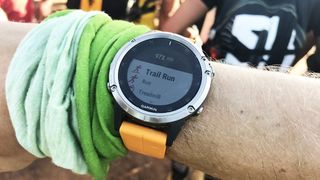
The Garmin Fenix 5 Plus is a rugged watch for the rugged user, the kind of person who’s just as at home in a canoe as they are in the desert or flinging themselves off a mountain.
Multisport adventure watches like this aren’t often that pretty to look at. If the Garmin Forerunner watches are like having a sleek sports car parked in your driveway, the hard-wearing Fenix range has been much more like parking a tank there.
However, the Fenix 5 Plus shows just how far Garmin has come on the design front. It’s still clearly a chunk of watch but at the same time, you’ve got something you can wear all day with smart clothes, without feeling like you’re making a statement about how SAS you are. In short, it’s a very nice looking and sophisticated – if a bit big – piece of kit.

We tested the 47mm Garmin Fenix 5 Plus sapphire crystal titanium with Solar Flare Orange Band, which has more than a touch of the Hugo Boss about its overall appearance.
There are, however, various models to choose from. The 42mm Fenix 5S Plus, the 47mm Fenix 5 Plus and the 51mm Fenix 5X Plus.
The standard Fenix 5 Plus weighs in at 86g – that’s 5g heavier than the Suunto 9 – unless you pay a premium for the 10g lighter, 76g titanium version.
On the average-sized wrist of our male tester the 47mm felt proportionate and manageable, though the smaller-wristed will almost certainly prefer the 42mm and even that might be a bit bulky for some.
We liked the fact the 47mm was a little smaller than the Suunto 9 and though there’s slightly less screen real estate, you don’t really notice the difference when you’re mid-activity.
There’s a sapphire crystal edition in all three sizes with a scratch-resistant sapphire lens designed to take all the knocks and bumps. We put this through a thorough examination out among the rocks and sand of the Half Marathon des Sables in Fuerteventura, and the screen came back in perfect health, though the titanium bezel did pick up a few minor scratches.

On cheaper versions those bezels come in stainless steel rather than titanium and you can choose a silver or a matt black finish. On the 47mm and 51mm watches the bezels are punctuated nicely by five screws that add a decent bit of detailing that you don’t get on the 42mm.
The 47 x 47 x 15.8mm watch face is smaller than the Suunto 9, with the display sitting inside a small border and taking up 30.4mm.
There’s room for four stats on screen at any one time in various customizable layouts, though we felt three stats was enough, anything more and things started to get a little cramped and lack hierarchy. That’s still plenty though.
The screen is a full-color transflective Garmin Chroma Display with LED backlighting and even in incredibly bright sunshine in the desert sands of Fuerteventura we found it easy to read. We also used it on a night stage for running in the dark using a head torch without any problem at all.
The clarity isn’t as sharp as you’ll find on something like the Apple Watch 4 but the only time this becomes a real issue is using some of the mapping features. And then again, the Apple Watch 4 won’t take the hard knocks this will.
There’s no touchscreen here like you get with Suunto’s flagship watch, instead the Fenix is controlled using five side buttons that are nicely responsive and easy enough to find on the move. Is it missed? It’s very much a subjective thing but touchscreen controls aren’t that easy to use when you’re bouldering up a cliff side or speeding down a mountain trail, so we weren’t that bothered.
We would have liked to be able to swipe the maps to make more of the Fenix’s new full-color topographic routable navigation but otherwise we weren’t that fussed. Some people might prefer to have the option for navigating post activity. If that’s you, this will irk you.
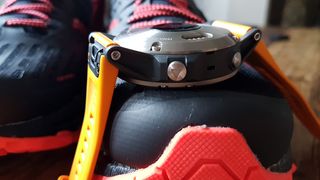
The silicone straps range for wrist sizes from 163-249mm and you can choose from silicone, leather and metal. It’s stupidly simple to switch the straps, with probably the best clip mechanism we’ve seen on a sports watch.
The silicone strap we tested was perfectly comfortable for long periods (we ran the long stage of the Half Marathon des Sables for 11 hours with no trouble).
Flip the Fenix over and there’s the standard Garmin Elevate-powered optical heart rate sensor with three green LEDs sitting in the center of the domed metallic back.
The sensor bump – yes that is the technical term – protrudes far less than on the Suunto 9 or the Polar Vantage V, but because of the dome there’s still good contact with the skin without any discomfort on longer runs. Yes it leaves a little mark, but so do all optical heart rate sensors.
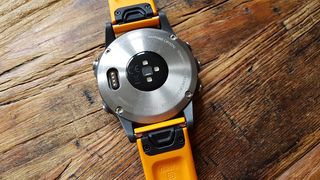
Next to the optical sensor you have the Garmin charge dock, a four-pin affair that clips firm when you put it on charge and comes with a cable that’s less bulky than some.
When it comes to sensors, on the navigation front, the Fenix 5 Plus packs a three-axis compass, gyroscope and barometric altimeter as well as multi-satellite (GPS, GLONASS and Galileo) capability to track in more challenging environments than GPS alone. More on the accuracy later.
There’s also an accelerometer for tracking indoor running and activities, such as strength training, plus a thermometer, handy if you’re pushing extremes.
There’s 16GB of memory for your music and workout history, though with the auto-sync over Wi-Fi and Bluetooth syncing if that’s patchy, you’re unlikely to push the limits.
For the swimmers, triathletes and water sports enthusiasts, the Fenix is water-resistant to 10ATM, so pool and open water swimming are covered but diving to any great depths however is not recommended.
- Find the best deals on Garmin products with our Garmin promo codes.
